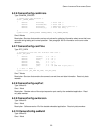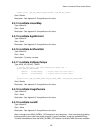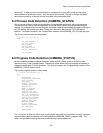SERIAL INTERFACE DEVELOPERS GUIDE
Index [3]: DSP Channel B3
6.2.24 CameraConfig.btnPanel
Type: BTN_PANEL
/* Button Panel State Structure */
struct _BTN_PANEL
{
unsigned menuUpdate:1; /* Set if button was pressed and menu needs update.
Should only be set by Host and only cleared by camera. */
unsigned actMenuID:7; /* Active Menu or message ID from enumeration */
unsigned actCursor:4; /* Current or active cursor location */
unsigned menuRows:4; /* Number of rows in menu */
/***** Camera Only Access *****/
unsigned reservedA:1;
unsigned prevMenuID:7; /* Previous Menu or message ID from enumeration */
unsigned prevCursor:4; /* Previous cursor location */
unsigned execState:2; /* Execution state for main loop processing */
unsigned reservedB:2;
}; /* 2 Words */
typedef struct _BTN_PANEL BTN_PANEL, *PTR_BTN_PANEL;
Size: 2 Words
Description: Structure that is modified by an attached custom button panel for menu control of
camera. Do not modify this data.
6.3 Dynamic Configuration Structure (NVM_GLOBAL_CFG)
The dynamic configuration structure is the first structure member included in the global configuration.
It contains settings that control the camera’s ‘look and feel’. Typical settings include selection of video
and overlay palettes, AGC mode, reticle position, and additional features. The type definition of the
structure is located in
XAppendix AX.
On boot - the structure is filled with data that is read back from a subset of the nonvolatile RAM on the
real time clock chip. This is the reason for the ‘NVM’ being a part of the member name. A complete
description of the contents of the nonvolatile RAM is located in
XAppendix EX.
During program flow the software will use the settings located in the NVM_GLOBAL_CFG structure to
control behavior. The host can read these settings to determine the existing state and then use the
‘McbWriteDataMem’ routine to change a setting.
The paragraphs below will provide information about each of the data members (excluding reserved
areas) in this structure.
6.3.1 nvmData.CamMode
Type: UWord16
Size: 1 Word
Description: See
XAppendix EX for specifics on this value.
6.3.2 nvmData.FpaMode
Type: UWord16
Size: 1 Word
Description: See
XAppendix EX for specifics on this value.
26


















